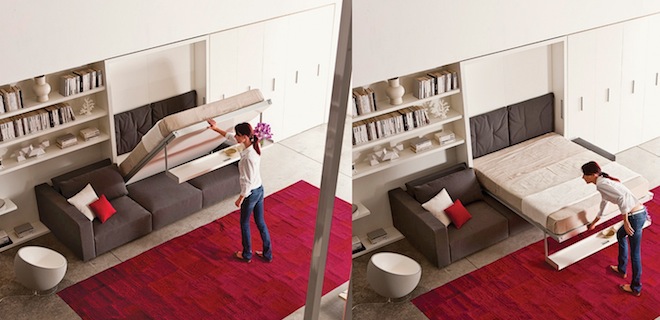The Murphy bed gets a makeover
A bookcase you can dine at, then sleep on.
Ciel
Share

Stepping into Resource Furniture’s downtown Toronto showroom is like walking onto the set of a James Bond movie. There’s a full-length shelving unit that, with a few quick manoeuvres, transforms into a queen-sized bed, an unassuming end table that extends to seat 10 people, and no trace at all of the cumbersome Murphy bed Lucy Ricardo got trapped inside, once upon a time.
Resource opened in Toronto two years ago, an answer to the city’s condo boom. A franchise with locations across Canada, as well as in New York City and Los Angeles, it is the exclusive North American dealer of Clei, an ultra-modern line of space-saving furniture made in Italy. Clei capitalizes on the cool factor (it’s been featured in the Wall Street Journal and on W Network’s Love it Or List It, among others), but its larger appeal is function. Shrinking housing sizes in urban centres such as Toronto and Vancouver means homeowners are determined to make the most of their living areas.
“People don’t want to leave one room for a guest who might come three times a year,” says interior designer Michelle Mawby. Reversible furniture allows a room to operate as two separate spaces. But innovation doesn’t come cheap. Mawby’s client Gary Prosserman recently purchased the Swing unit from Resource—a queen-sized bed that opens vertically and is integrated with a nine-foot chaise sofa and bookshelf. It costs about $16,500. Prosserman, who works in finance, decided on the bed after “downsizing” six months ago from his home in the Toronto suburb of Thornhill to a 4,000-sq.-foot townhouse in north Toronto. He and his son have their own bedrooms, but Prosserman was torn between turning the remaining room into a home office-den or an extra bedroom. “I realized I can have both,” he says. He felt he could justify the steep price because “it basically added a whole extra room to my house.”
Seamless mechanisms and sleek design are what people are paying for. But Mawby admits most of her clients won’t spend tens of thousands of dollars just to save space. Buyers may opt for a less costly Murphy bed, which runs from $1,500 to $3,000 and is available everywhere, from private furniture-makers to Costco.
Conceived in Calfornia in the early 20th century, Murphy beds peaked in popularity in the 1920s and resurged in the ’70s as a recession and other factors forced Americans to live on less. Now shifts in urban living are driving the revival. For 27 years, B.O.F.F. Wall Bed Furniture has sold custom-built wall beds. Founded in Montreal, the company has branches in Vancouver, Calgary, Ottawa, Toronto and Boston. Though business has been steady, owner Marco Fontaine says it’s been elevated to “a different level” with the influx of condos. B.O.F.F.’s beds can fit a variety of spaces and, compared to Clei, the company keeps things simple. Sure, they can build cabinets or closet space around a bed, but there are no dining tables or shelves hanging off the front. And with good reason. “They don’t last,” Fontaine says. Years ago, B.O.F.F. attempted similar projects and found repairs were frequently needed. “It’s too much weight on the front of the bed. It’s nice on paper and it’s nice in the beginning.”
Calgary furniture designer Carrie Luterbach of Custom Wall-Beds has another beef with bed-table hybrids. “There’s nothing pretty about them,” says Luterbach, who is in the midst of a project that requires dozens of double beds that will also serve as desks, for the University of Calgary’s new residential towers. The company has been commissioned to install Murphy beds inside the U of C’s nursing school for practical exams, as well as at a sleep disorder clinic. Its bread and butter, however, is custom wall-beds; one client had a bed installed in the kitchen of her studio apartment.
Luterbach says the market is shifting. “Before, in Calgary, we had lots of room, so everything was also bigger. We are only starting to see really, really small spaces,” she says. With young people headed to the city in record numbers, the trend is bound to grow. “We are going to see more younger people going in this direction, because they can’t afford anything else.”